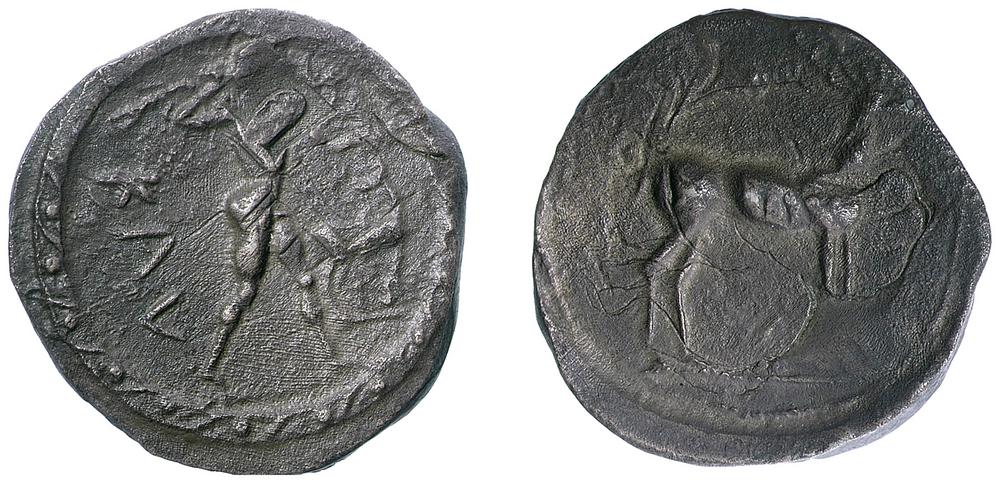2424 - Caulonia (nomos Apollo/stag) over Corinth (Pegasus/incuse square) (London, BM, 1913-1-5.1)
From SILVER
475 BCE - 425 BCEΚΑΥ
Images
Overstriking coin

SO 178 - Caulonia over Corinth.jpeg [1]
Location/history
| Museum collectionMuseum collection: | London, British Museum, 1913,0105.1 | |
Overstriking coin
Description
| ObverseInscription or printing placed on the obverse.: | ΚΑΥ (Greek) Apollo advancing right, naked, brandishing laurel branch. In right field, stag right. | ReverseInscription or printing placed on the reverse.: | Stag standing right. |
Mint and issuing power
| MintIdentifies the place of manufacture or issue of a numismatic object.: | Caulonia | Ancient regionAncient region. | Bruttium | Modern countryModern country: Italy | AuthorityIdentifies the issuing power. The authority can be "pretended" when the name or the portrait of X is on the coin but he/she was not the issuing power. It can also be "uncertain" when there is no mention of X on the coin but he/she was the issuing power according to the historical sources: |
Chronology
| FromIdentifies the initial date in a range assigned in a numismatic context. 475 BCE toIdentifies the final date in a range assigned in a numismatic context.. 425 BCE | Classical 480-323 BC |
Physical description
| MetalThe physical material (usually metal) from which an object is made.: Silver |
WeightWeight of the numismatic object (in grams). in grams: 7.327.32 g <br />7,320 mg <br /> | DenominationTerm indicating the value of a numismatic object. Examples: tetradrachm, chalkous, denarius.: nomos | |
| DiameterDescribes diameter of an object (in mm).: 2222 mm <br />2.2 cm <br /> | StandardStandard.: Achaian | ||
References
| Coin referenceReference of the Coin: | Noe 1957, p. 13-42, pl. V-XIV (group II, p. 22, pl. VI, h), Hill 1914, p. 98-99 | Coin series referenceReference to coin series study: | HN Italy1HN Italy, n° 2044, 2046, 2049, 2051-2152, HGC 12HGC 1, n° 1419 |
| Coin series web referenceCoin series web references: | |||
Overstruck type
Description
| ObverseInscription or printing placed on the obverse.: | Pegasus | ReverseInscription or printing placed on the reverse.: | Swastika |
Mint and issuing power
| MintIdentifies the place of manufacture or issue of a numismatic object. ᵖ: | Corinth | Ancient regionAncient region. ᵖ | Peloponnesus | Modern countryModern country: Greece | AuthorityIdentifies the authority in whose name (explicitly or implicitly) a numismatic object was issued. ᵖ: |
Chronology
| FromIdentifies the initial date in a range assigned in a numismatic context. 540 BCE toIdentifies the final date in a range assigned in a numismatic context.. 425 BCE | Classical 480-323 BC |
Physical description
| StandardStandard. ᵖ: | stater |
References
| Coin type referenceReference to coin series study ᵖ: | Ravel 19363Ravel 1936, n° 86-90, Calciati 19904Calciati 1990, period I, class 2 | ||
| Coin series web reference overstruckCoin series web references overstruck: | |||
Additional data
| Frequency of overstrikesFrequency of overstrikes: | frequent | Level of confidenceLevel of confidence of the identification: | sure |
| RemarksRemarks: | |||
References
- ^ Rutter N. Keith et alii (eds.) (2001), Historia Numorum Italy, London, xvi, 223 p., 43 pl.
- ^ Hoover, Oliver D. (2018), The Handbook of Greek Coinage Series, Volume 1. Handbook of Coins of Italy and Magna Graecia, Sixth to First Centuries BC., Lancaster-London, 2018, lxi, 527 pages, 23 cm
- ^ Ravel, Oscar E (1936), Les "Poulains" de Corinthe : monographie des statères corinthiens. Tome I: de 650 à 415 J.-C., Basel.
- ^ Calciati, Romolo (1990), Pegasi, Mortara, Edizioni I.P..
